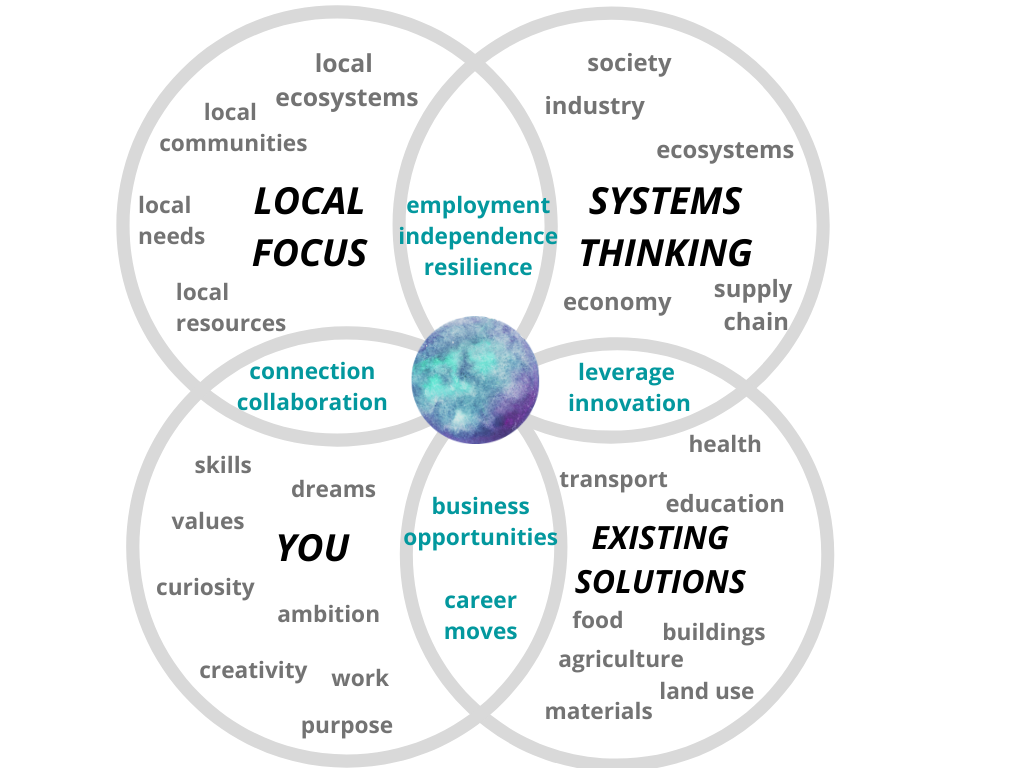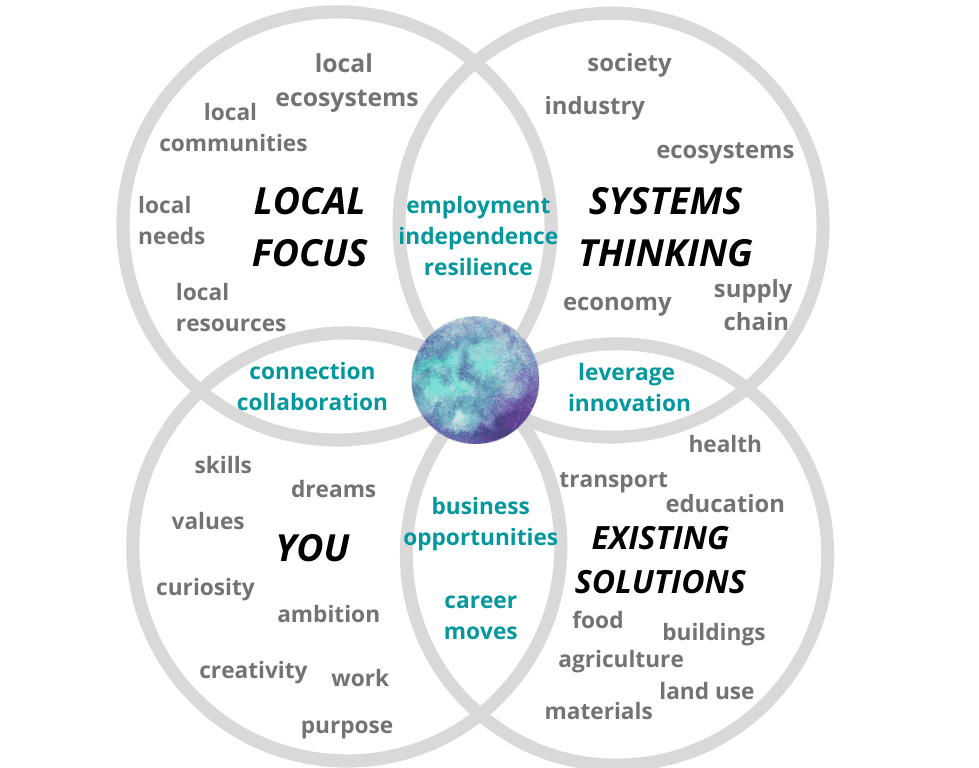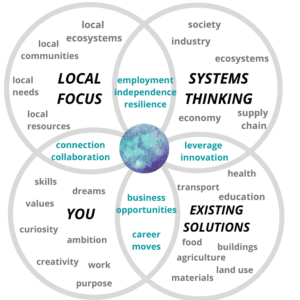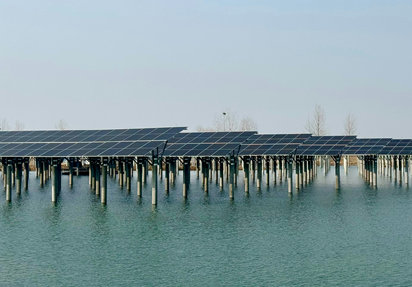Leigh Baker | September 1, 2023
(Developed from a Balance3 post written in 2021)
Ikigai is commonly known these days as the intersection of your purpose in life with your work in the world. It’s often referenced as a Japanese concept.
“…it is said that everyone has an ikigai – their particular intersection of passion, talent, and potential to benefit others. It is only a matter of finding it.”
Psychology Today – The Philosophy of Ikigai
An Ikigai diagram is often presented as a tool for exploring connections between:
- What you love
- What you are good at
- What the world needs
- What you can get paid for
According to Japanologist Nick Kemp the above diagram is simply a Purpose Diagram – and it’s anything BUT Japanese.
To Kemp, Ikigai is a life philosophy, not just a Venn Diagram – it’s a process for living.
“Ikigai is not just a career related framework of doing something that you love, that you are good at, that the world needs for which you can be paid for. Ikigai is your journey to self actualization, one that twists and turns, and is filled with small joys and major life challenges.”
Nicholas Kemp, Ikigai Tribe
Nick explains this deeper interpretation of ikigai, and how it can be applied to unlock joy and satisfaction in one’s life here.
Regardless of what you chose to call this type diagram – with a bit of adjustment it can a useful tool for exploring your pathway to regenerative action.
Regeneration, career (or business) development and personal purpose
One of the dis-empowering aspects of acting on the multiplying challenges of extractive economics – climate change, poverty, ocean plastics or forest destruction to name a few – is that it can seem:
- Really, really, REALLY big and overwhelming.
- That as individual people or organisations, we have little direct power or impact.
- The solutions delivery is primarily for big government and big business.
- Our best contribution is to play small as we attempt to limit “excessive consumerism”.
- Action on the issues mostly costs a lot and doesn’t return anything to the actor.
And that’s an incomplete picture…. one that shuts down a lot of people.
Regeneration is achievable – and achievable starting NOW
Today’s commercial solutions offer planetary regeneration
Humans being human, it took until 2014 (!?!?!?!?!?!) for someone to actually start to “do the math” and answer this question:
Can we reverse global warming just using the commercial, scalable solutions we already have?
Project Drawdown
Can we use what we have to draw down greenhouse gases from the atmosphere in time to stabilise our climate?
The answer was basically “Yes, as long as we take a whole-of-economy view (and pull our fingers out)”.
“What can we do today?”
The Drawdown team modelled and ranked the commercial, scaling solutions with peer-reviewed data to support them. Their initial modelling published in 2017 found over 80 solutions across the full spectrum of economic activity – from education and health to transport and industry. Their 2022 modelling brought the tally to 93 evidence-based commercial solutions.
“When could we achieve draw down?”
That depends on how quickly we act and how accurately we focus.
“In Scenario One, we’re pretty aggressive about it. And in Scenario Two, we’re wildly aggressive about it. We find we can stop climate change around the mid 2040s at the earliest. And maybe by the late 2050s, early 260s at the latest.”
Dr Jonathan Foley, Drawdown 101
Drawdown also found something else that you might NOT have heard in your news feed about investing in regenerative solutions:
“We’ve got to pony up a little bit of money – about $20 to $30 trillion. If we do this, and we do it over about two to three decades, we actually make between $90 and $150 trillion back.
This is incredible, because we’re going to save a lot of money, we’ll make new revenues. And in fact, this is probably the biggest business opportunity in human history.“
Dr Jonathan Foley, Chief Executive of Project Drawdown Drawdown 101
And it gets even better:
“These solutions are no regrets solutions!… We would want to do them if there wasn’t a climate scientist alive and we were clueless as to what causes extreme weather. Still we would want to do these! “
“They have so many benefits in terms of jobs, prosperity, our children, clean water, clean air…. it goes on and on and on.”
Paul Hawken, Drawdown: The Most Comprehensive Plan Ever Proposed to Reverse Global Warming
Regeneration is actionable today
When Project Drawdown’s founder Paul Hawken got the “yes” answer – and a whole lot of surprises about what the top solutions were – his next question was:
“What can WE do? Now, today? What can individuals and communities do that doesn’t need us to wait for ‘policy’ and ‘agreements’?”
Hawken moved on to answering this question, and launched Project Regeneration in 2021. The Project Regeneration experts have now compiled and update over 70 action lists for individuals, communities, regions, SMEs and industries.
Opportunity is EVERYWHERE!!!
Once you retune your brain to regeneration, your problem isn’t going to be FINDING something to do – your problem is going to be CHOOSING which solutions will be most rewarding to you.
Today’s rich smorgasbord of regenerative solutions offers a wealth of business, career, community and personal development opportunities.
That’s where my Regeneration Ikigai can be useful. It’s a way to map out:
- The systems you’re part of.
- The place where you want to play the regeneration game.
- The things that “light you up and turn you on”.
- The existing solutions opportunities you can leverage.

You don’t need to sit on the sidelines as a worried watcher, desperately hoping someone out there will fix things.
You can be out there today, playing the regeneration game today – and enriching your life by doing it.
Why miss out on today’s rich opportunities?
Why sit on the sidelines when there’s good to be done pretty much everywhere?
There’s a whole spectrum of innovation to be delivered – and fun to be had and work to be done – as we transform our civilization, our economy and our relationships to each other and the places we live.
So what’s there to do?
The great thinkers of our times – in both the 20th and 21st centuries – have told us what to do:
“You never change things by fighting the existing reality. To change something, build a new model that makes the existing model obsolete.”
Buckminster Fuller
So to be an effective, high-impact climate solutionist you need to understand the limits of the existing models and the best ways into the exciting new models replacing them. (For example: Circular Economy, Biomimicry and Systems Thinking.)
You also need to understand the global, high-impact, no-regrets solutions we already have:
“We can reach Drawdown by mid-century if we scale the climate solutions already in hand… there is no reason… to wait on innovation. Now is better than new… If we pursue climate solutions with purpose and determination… we could reach Drawdown as early as the mid-2040s…” (emphasis added)
Project Drawdown 2020 Review
Our thought leaders remind us that the places for action are many and varied (and often not big government):
“Never doubt that a small group of thoughtful, committed citizens can change the world; indeed, it’s the only thing that ever has.”
Margaret Mead
And with a whole economy to realign, there’s an opportunity smorgasbord out there – so you can align your efforts with what gives you energy and inspiration.
“If I tell you what you ‘should ‘ do – you should RUN! Do what lights you up! Do what turns you on!”
Paul Hawken
Project Regeneration’s Action Nexus is full of lists for individuals, communities, regions and SMEs – so you don’t have to be a climate scientist or an industrialist to take action today.
“Climate change may leave people feeling as if they have to make a choice between “saving the planet” and their own happiness, well-being and prosperity. Not at all.
Regeneration is not only about bringing the world back to life; it is about bringing each one of us back to life. It has meaning and scope; it expresses faith and kindness; it involves imagination and creativity.
It restores forests, lands, farms and oceans. It transforms cities, builds green affordable housing, reverses soil erosion, rejuvenates degraded lands, and power rural communities.
It is inclusive, engaging, and generous. And everyone can do it.”
REGENERATION: ENDING THE CLIMATE CRISIS IN ONE GENERATION
How can you become a regeneration leukocyte?
Leukocyte: White blood cell, also called …. white corpuscle: a cellular component of the blood that … is capable of motility, and defends the body against infection and disease… (emphasis added)
Encyclopedia Britannica
We’re in the process of a whole-of-economy transition – creating new relationships with each other and with the ecosystems that deliver our food, water, air and weather.
(It’s a transition that may or may not succeed. Not all caterpillars successfully live to become butterflies.)
However, the more active leucocytes a body has, the better its chances.
Re-imagining YOU
And so this is feedback and it’s feedback to inspire us to reimagine what it means to be a human being…. at this point in time in civilization. And to reimagine what it means to be an architect, an engineer, a student, a farmer, a forester, a wife, a child. To be all the things that we are.
Paul Hawken, Drawdown Lecture at UQ
Part of that transition is developing a new relationship with our selves – with our work, our values and our purpose.
These reflections from Nick Kemp could also help you start exploring where you might access energy and authenticity:
- Life satisfaction – in the practice of your craft, hobbies or interests that support your values.
- Harmony and connection – where your values align with your roles and relationships.
- Purpose and gratitude – when you are hopeful of the future and present in your roles and relationships.
- Creativity and transformational experiences – by expressing your creative self and in seeking new experiences.
Four perspectives for planning your regenerative future
A lot of us have been programmed to believe that we need big government delivering big solutions to make the world better.
For me – having watched decades of disruptive technology innovation being delivered – both as a supply chain analyst and a business coach – that’s not how the world changes in the 21st century.
Like our phones and computers, smart distributed solutions are economic innovations – and often get their start in garages and spare bedrooms.
(Which isn’t to deny the need for better government policy – but we need MORE than policy.)
There is a world of commercial and career opportunity today – and it could well be passing you by if you’re not watching for it.
These 4 perspectives can help you tune your brain to hunt for your opportunities:
- Learn about today’s wealth of practical, commercial and community regeneration solutions. The most powerful solutions today are the ones we HAVE today that we ACTION today. Focus on scaling what’s already working.
- Observe the behaviour of the systems you’re part of – particularly the drivers that motivate the behaviour they generate. The community you live within, the industry you work within, the local economy you’re part of – they’re all human systems that can change quickly when they’re made a relevant, positive offer.
- Look locally for opportunities – yes we have multiple global challenges – but everything is connected. Making your bit of the world better creates inspiration for others in their bit of the world.
- Start with you – your talents, your passions, your work, your location – focus on what lights you up and turns you on. Everything needs reinventing – AND all the good solutions multiply each other. You’ll get sustained energy from what motivates you anyway. (There are 8 billion plus others who can do the bits you don’t.)
So what are some, useful, accessible starting points?
1. Learn about regenerative solutions
Fundamentally, our challenge is to develop economies that regenerate the ecosystems and communities they operate within (and cannot exist without).
So it’s also important to learn about the growing set of regenerative solutions already being scaled – solutions like:
This isn’t about years of deep study – this is about exploring the mindsets and principles in play. Reading articles and listening to selected video and audio will help you “grok” their potential.
When you understand the practical possibilities of these solutions then you can navigate towards finding “your thing” – the thing that lights you up, turns you on and gives you small joys and great challenges.
“Give me a place to stand, and a lever long enough, and I will move the world. ”Archimedes
With a sure foundation in self-knowledge and the innovation lever of regenerative design, you’re in a more powerful position to “be the change”.
2. Focus on systems behaviour – not just symptoms
Always remember that the problems we face are caused by our systems – the human systems that we call “business” and “the economy”. They were never designed to preserve and restore communities or ecosystems – so they don’t.
The solutions we need involve systems-level enhancements. So we don’t just need to generate more renewable energy – we ALSO need a smarter grid and more storage along with demand-reducing solutions like insulation and water efficiency.
So when you explore the systems that you’re part of – your local economy, your industry, your supply chain, your community – then you’re more likely to find the truly powerful and often surprising leverage points they hold.
TIP: If you haven’t heard of Systems Thinking – or it keeps falling off your “round-TUIT” list – now might be the time to get an overview. It’s an enormously valuable career skill, not just “some greenie thing”.
My personal favourite as an introduction is Stroh’s excellent book SYSTEMS THINKING FOR SOCIAL CHANGE – but there are also plenty of online resources you can get started with.
3. Think local first
What’s happening in your area, your industry, your work, your community? Where are there resources, needs, opportunities and systems that smarter design thinking and unexplored solutions could fill?
Individuals acting to meet local needs using local resources and creating local jobs are creating awesome solutions, whether it’s an Insulation Revolution in Western Australia or a Totally Renewable township in Yackandandah.
4. Play to YOUR strengths
Find something that works for you – something that will improve your personal situation.
Map out your strengths, your skills, your talents, your passions and your place. Scan for ideas and solutions that ping your “curiousity button” – and explore them even if they don’t make sense at a logical level.
It can also be useful to “reverse engineer” backwards from what scares, angers or dismays you – because your “thing” might be found in the solution that addresses it.
The name of the game is regeneration
We don’t just need to “slow” or “stop” ecosystem exploitation and destruction, we need to reverse it – starting today. Likewise community exploitation.
That means that we need to regenerate our ecosystems and restore their function as powerful, active carbon sinks. To do this we also need to regenerate the communities that inhabit those ecosystems – so they can benefit from repairing and restoring them.
Regeneration puts life at the heart of every decision – so why not explore what it offers for your next career decision?
We know how to do these things today….
AND they offer a space rich in innovation and opportunity…
DON’T miss out on your piece of the action!!!









